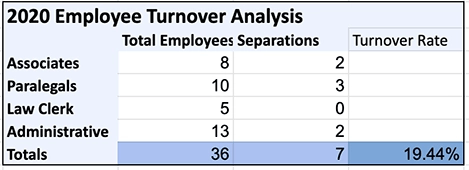You can’t have a business without people. This is why high turnover rates mean troublesome damage for any business. Law firms are no exception. Clients expect them to be strong in consistency and stability.
High turnover can be both an indicator of something gone wrong and a harmful event in itself. When a firm experiences high turnover, it loses out in a number of ways, including decreased capacity for billable hours, decreased expertise, wasted startup costs and recruitment fees, and sometimes lost clients. This scenario can also easily turn into a feedback loop.
Turnover is a simple calculation:
The number of separated employees
divided by
The number of employees that you started out with
It’s the rate at which you’re losing people, viewed as a percentage. Even if your firm is healthy, it will be helpful to calculate this number. You will want a baseline number to refer back to.
On the other hand, if your firm is unhealthy, knowing your turnover rate is a great way to be forewarned. Knowledge is power.
How to Calculate Turnover
A Simple Case
When you pull together the data that you need, it is simplest to review one year at a time. The single turnover rate from one year’s worth of data can give you an idea of whether your firm might be in danger.
You can also calculate turnover for individual years and then compare the rates for new insights. Maybe management improved, employee compensation increased, or someone who did not work well with the team had left.
1.) First, you’re going to need access to a roster of employees for the period of time you want to review. Let’s say you have your roster of employees from 2020.
2.) Identify the number of people that were actively employed as of January 1st, 2020. Say it’s 36.
3.) Then, identify the number of employees who quit, were fired, or otherwise terminated between January 1 and December 31. Let’s say it’s 7.
4.) 7 ➗36 equals about 0.1944, or 19.4%. That is the turnover rate for 2020.

Always be sure to either (1) exclude new hires from your numerator and your denominator, or (2) include them in both. A turnover rate that includes new hires will usually be close to one that does not.
In other words, use this method:
|
2020 separations, except for 2020 new hires who separated |
| # of employees on January 1, 2020 |
Or use this method
|
2020 separations, including 2020 new hires who separated |
| # of employees on January 1, 2020 + # of new hires in 2020 |
At this point, you have all you need to get started. But you may have realized that you can also slice and dice the data for more insights. For example, what is the turnover rate among just your associates? Can you compare the turnover rates for associates between the years 2019, 2020, and 2021?
The key in every scenario is to know both your group and duration parameters and carefully stick with them, or else you may end up with a number that isn’t representative of what’s going on. For example, don’t compare turnover rates from different durations of time. A 5% turnover monthly rate is potentially catastrophic, but a 5% turnover rate annually is likely workable.
Related: Employee Replacement
Now you know your turnover rates, but do you know how well you are replacing lost employees? You may have noticed in the example that the new hires were not making up for terminations. Unless you are careful, this is how turnover can place strain on the rest of the team. In the long run, managers benefit by taking note of what has been lost so that they can strategically replace it without too much lag time.

Related: “Good” and “Bad” Turnover
Speaking of attorney productivity, what exactly did you lose when those two associates left? Losing a profitable associate is a blow and it might help to identify the causes for her departure.
But is losing an unprofitable associate a good thing?
Someone can be unprofitable for many reasons besides sheer laziness - like lack of incentive, poor work environment, insufficient training, or burnout. In the case where an attorney was indeed a bad hire, it can help to understand what part of the hiring process might need additional attention.
This is one of the many ways in which turnover can actually be converted into an opportunity to learn more about your firm and enhance its processes.

DON'T MISS Part 2 of this article about law firm turnover will discuss how a law firm can deal with turnover, including the top preventative and just-in-time solutions to combat the dangers law firm turnover can bring.
Sign up below to receive our latest blog posts so you don't miss out on any of our law firm management content!
.webp?width=124&height=108&name=PerformLaw_Logo_Experts3%20(1).webp)


